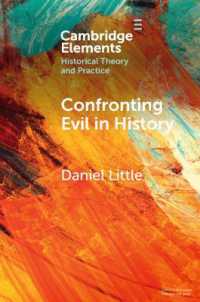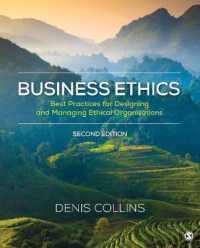- ホーム
- > 洋書
- > 英文書
- > History / World
Full Description
The history of the island of Ireland is both complex and connected to the wider world: it was the first place in the British and Irish archipelago to be settled by Christian monks, and has suffered Viking invasion, Norman colonization, British decimation, mass migration to the New World, civil war and eventually independence for Éire in the early 20th century. Despite its often troubled past, Ireland is today a dynamic island with a blossoming economy and culture. Arranged chronologically from ancient times to the 21st century, History of Ireland provides a pictorial exploration of a land that is well-known but often little understood. Discover the remains of the country's many Iron Age hill forts, such as the atmospheric stone fort at Grianán Aileach; explore the first Christian colonies in the monastic settlement at Glendalough in County Wicklow; read of the legend of St Patrick, and stood atop a hillside and banished snakes from Ireland - prompting all serpents to slither away into the sea; discover the Book of Kells, an illuminated manuscript of the Celtic Gospel written in the 9th century; learn about the Plantation of Ulster in the 17th century, where English and Scottish settlers established Protestant communities, causing lasting communal strife; understand the Easter Rising and the traumatic war for independence, which led to Ireland's current political shape; and experience modern Ireland, a place of prosperity, with thriving cities like Dublin and Belfast alongside beautiful countryside.
Contents
Contents:
Pre-Christian Ireland Iron Age - During the fifth century the main kingdoms of In Tuisceart, Airgialla, Ulaid, Mide, Laigin, Mumhain, Cóiced Ol nEchmacht began to emerge.
The Coming of the Gospel The spread of Christianity in fifth-century Ireland is inextricably linked with the iconic figure of St Patrick. The development of Christianity was fundamental to the evolution of an Irish cultural identity, and helped to maintain the flame of learning and education in Europe during the chaotic centuries that followed the fall of Rome.
Vikings and Normans The first recorded Viking raids on Ireland took place in 795 AD, when islands off the north and west coasts were plundered. In the summer of 1167, a small band of Anglo-Norman adventurers sailed from Pembrokeshire and landed on the County Wexford coast. It was a seismic moment in Irish history, marking the establishment of the Lordship of Ireland: in effect, the first English colony.
Protestants and Catholics In the spring of 1606, a wave of Scots settlers came ashore in County Down. This was the beginning of the Plantation of Ulster: a systematic British and Protestant settlement of the northern half of Ireland. With the defeat of a Spanish expeditionary force at Kinsale in County Cork at Christmas 1601 came the definitive victory of English military power in Ireland - a fact emphasised by the 'Flight of the Earls' in 1607, when a large proportion of Ulster's Gaelic aristocracy fled Ireland for the continent. The sack of Drogheda - In August 1649, Oliver Cromwell and his New Model Army landed at Dublin. Cromwell was eager now to settle affairs in Ireland, where anarchy reigned and the royalist faction retained significant support. Battle of the Boyne - The battle of the Boyne was fought on 1 July 1690, between forces of the deposed and exiled Catholic king, James VII of Scotland and II of England, and the Dutch Protestant new king, William II of Scotland and III of England (William of Orange). Battle of Aughrim - The Battle of Aughrim was fought in July 1691. It epitomised the final defeat of Catholic Ireland.
Famine and Emigration In September 1845, as the first potatoes were being lifted in fields across Ireland, word began to spread of a disease affecting the new crop. Blight was spreading across the countryside. Of a pre-famine population of some eight million, over a million died of hunger and famine-related diseases. In the century between the Napoleonic Wars and the Irish Civil War, more than seven million Irish men and women left their homeland to begin new lives abroad.
Independence Movements and Civil War Wolfe Tone dreamt of a radical, non-sectarian Irish republic. By the 1830s, a new leader had emerged onto the national stage. Daniel O'Connell understood the importance of enlisting the mass of the population as a means of achieving the repeal of the Act of Union. Easter Rising: Organised by a seven-man Military Council of the Irish Republican Brotherhood, the Rising began on Easter Monday, 24 April 1916 and lasted for six days. Civil War (1922-23): The conflict was waged between two opposing groups of Irish nationalists: the forces of the new Free State, who supported the Anglo-Irish Treaty under which the state was established, and the Republican opposition, for whom the Treaty represented a betrayal of the Irish Republic.
Modern Ireland Troubles in Northern Ireland - Bloody Sunday, British soldiers opened fire on the crowd. Good Friday Agreement - In April 1998, the Agreement was signed, setting out a framework for future political progress in Northern Ireland. Peace dividend: Ireland's economy became more diverse and sophisticated than ever before; integrating itself into the global economy by joining the European Economic Community (EEC), a precursor to the European Union (EU).








